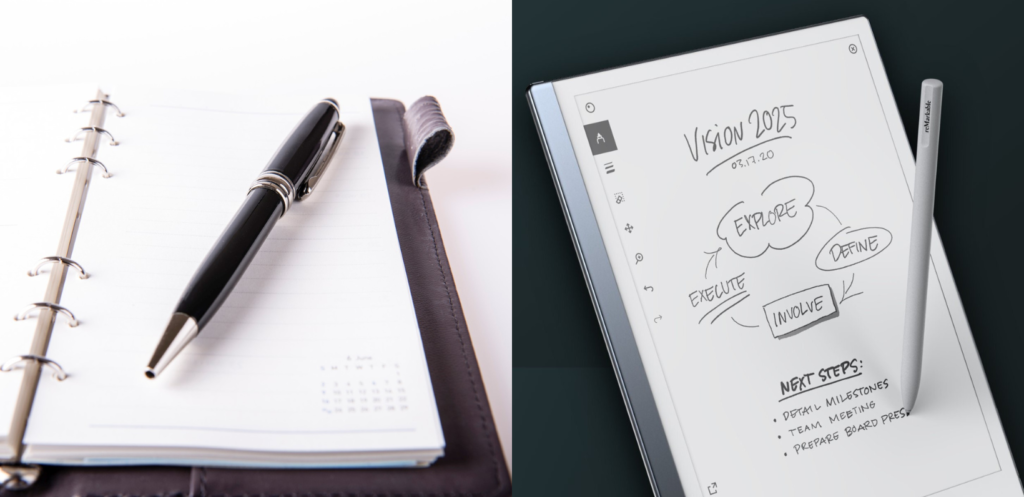
In today’s digital world, managing our time and staying organized is critical to productivity and success. As a result, people are using technology in any way they can to improve their daily lives. There is a wide range of options to choose from when it comes to planners, whether that be traditional paper or the use of a digital platform, and it can be challenging to decide on the best fit. Our survey showed that 75% of respondents preferred pen and paper. We will explore the pros and cons of both paper vs. digital alternatives to help you make an informed decision on which is best for you.
Traditional Paper Options
Pros
Paper notebooks are a classic way to keep track of tasks, appointments, meetings, and more. Studies have shown that writing down your appointments, goals, and tasks helps them stick in your memory better. Keeping your focus away from devices can also help you accomplish tasks quicker or more efficiently with less distraction.
By writing, we are able to clarify our thoughts and mindfully connect with exactly what we need to do, and what we want and aim for. 1
Bullet journaling or grid dot planners allow for creative customization since you are not bound to specific templates. With various options for a paper planner, you’re likely to find one that works best for your scheduling and note-taking needs. At-a-Glance is an example that provides different formats such as daily, weekly, or monthly planning with numerous sizes to best fit your needs.
Cons
One issue you may find when using paper is that you might forget about specific tasks if you don’t check your notes regularly. Written commitments won’t have a way to send notifications like digital platforms can. You must also remember to bring your planner everywhere if you don’t usually carry it in a bag.
Paper planners typically do not have the ability to set alarms or reminders, which can make it more difficult to stay on top of important tasks and appointments. 2
Lastly, paper planners provide limited space which might cause your planner to look messy over time if you have a lot to write and if you are making edits to your notes. Writing small enough to fit everything but large enough to read is tricky yet essential.
Innovative Digital Options
Pros
The use of digital platforms can be an excellent option for those who like to keep everything organized and in one place. Most workplaces have transitioned to a fully digital way of performing job functions, mainly because it makes sharing documents more accessible.
Many people find typing faster than writing things down. Typing lets you quickly get all appointments, tasks, and more into your schedule. Setting recurring tasks can also save you time from having to write something out many times when you know it will repeat regularly. Digital programs allow you to stay environmentally friendly by making your data easily accessible on the cloud.
Asana is an up-and-coming digital platform for planning, scheduling, and file sharing that allows you to complete tasks in different formats. It lets you connect with other Microsoft programs like Teams, Word, and more.
Cons
A downside to digital-only planning might be too many notifications in one place. If your phone or computer fills up with notifications, you may be less likely to see the important ones stand out.
Treating the alert as noise to be ignored, as the brain adjusts to the constant stimulation of the alerts. 3
The availability of use can also limit technology. Having to plug in or worry about battery life every time you need to re-configure your schedule can be troublesome if you are always on the road and don’t have access to your charger.
Too much screen time can cause eye strain and, as a result, make you feel more tired. Additionally, prolonged exposure to device screens may slowly impair your brain structure over time. Since many people work all or most of their days on a computer, having a paper planner may be a great way to escape screen time.
Hybrid Options
Many people choose to mix digital and paper planning. As mentioned, some people struggle with constant alerts, and their important notes may get lost in a sea of notifications. Finding a balance between digital and paper can allow you to get the benefits of both platforms, depending on your needs.
One excellent option that allows you to write notes down but has the accessibility of a digital platform is the reMarkable digital notebook. This paper tablet enables you to get the benefits of physical writing in your routine while making the notes you take accessible on your computer or laptop.
The Rocketbook is another great, more cost-effective option that uses special pages with the help of QR codes to upload notes, schedules, and more to a digital cloud. Using erasable pens, this sustainable option allows you to reuse the pages that you write on.
In Conclusion
When it comes to paper vs. digital, both have their own set of pros and cons.
No optimal way works for everyone when setting yourself up for success. Paper planners are great for specific agenda items that must be ingrained in your brain more. At the same time, a digital platform might be the preferred choice for more critical notes that need reminders. An integrated option may help if you want to change it up to spike your productivity.
Ultimately, the choice between the type of notebook or planner comes down to personal preference and what best suits your needs.
Sources:
3: https://www.imperva.com/learn/data-security/alert-fatigue/
The Perfect Partner for your Business Needs.
Curious about our other articles? Read more here or Return to our homepage.

